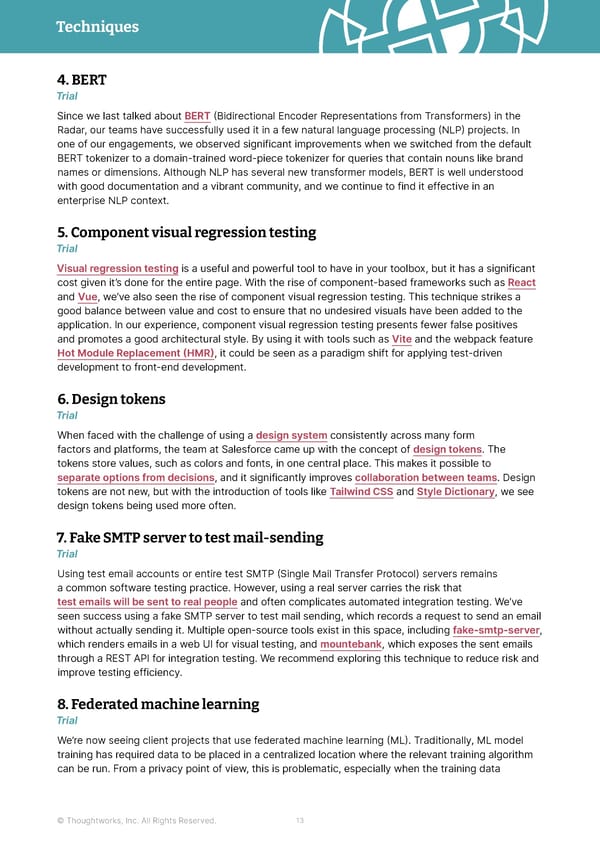Techniques Thoughtworks Technology Radar 4. BERT Trial Since we last talked about BERT (Bidirectional Encoder Representations from Transformers) in the Radar, our teams have successfully used it in a few natural language processing (NLP) projects. In one of our engagements, we observed significant improvements when we switched from the default BERT tokenizer to a domain-trained word-piece tokenizer for queries that contain nouns like brand names or dimensions. Although NLP has several new transformer models, BERT is well understood with good documentation and a vibrant community, and we continue to find it effective in an enterprise NLP context. 5. Component visual regression testing Trial Visual regression testing is a useful and powerful tool to have in your toolbox, but it has a significant cost given it’s done for the entire page. With the rise of component-based frameworks such as React and Vue, we’ve also seen the rise of component visual regression testing. This technique strikes a good balance between value and cost to ensure that no undesired visuals have been added to the application. In our experience, component visual regression testing presents fewer false positives and promotes a good architectural style. By using it with tools such as Vite and the webpack feature Hot Module Replacement (HMR), it could be seen as a paradigm shift for applying test-driven development to front-end development. 6. Design tokens Trial When faced with the challenge of using a design system consistently across many form factors and platforms, the team at Salesforce came up with the concept of design tokens. The tokens store values, such as colors and fonts, in one central place. This makes it possible to separate options from decisions, and it significantly improves collaboration between teams. Design tokens are not new, but with the introduction of tools like Tailwind CSS and Style Dictionary, we see design tokens being used more often. 7. Fake SMTP server to test mail-sending Trial Using test email accounts or entire test SMTP (Single Mail Transfer Protocol) servers remains a common software testing practice. However, using a real server carries the risk that test emails will be sent to real people and often complicates automated integration testing. We’ve seen success using a fake SMTP server to test mail sending, which records a request to send an email without actually sending it. Multiple open-source tools exist in this space, including fake-smtp-server, which renders emails in a web UI for visual testing, and mountebank, which exposes the sent emails through a REST API for integration testing. We recommend exploring this technique to reduce risk and improve testing efficiency. 8. Federated machine learning Trial We’re now seeing client projects that use federated machine learning (ML). Traditionally, ML model training has required data to be placed in a centralized location where the relevant training algorithm can be run. From a privacy point of view, this is problematic, especially when the training data © Thoughtworks, Inc. All Rights Reserved. 13
 Vol 27 | Technology Radar Page 12 Page 14
Vol 27 | Technology Radar Page 12 Page 14